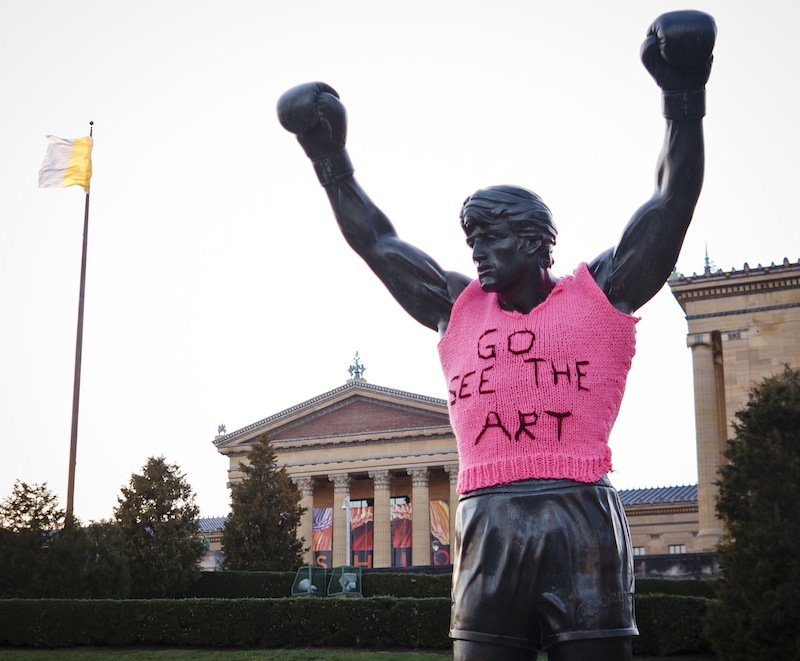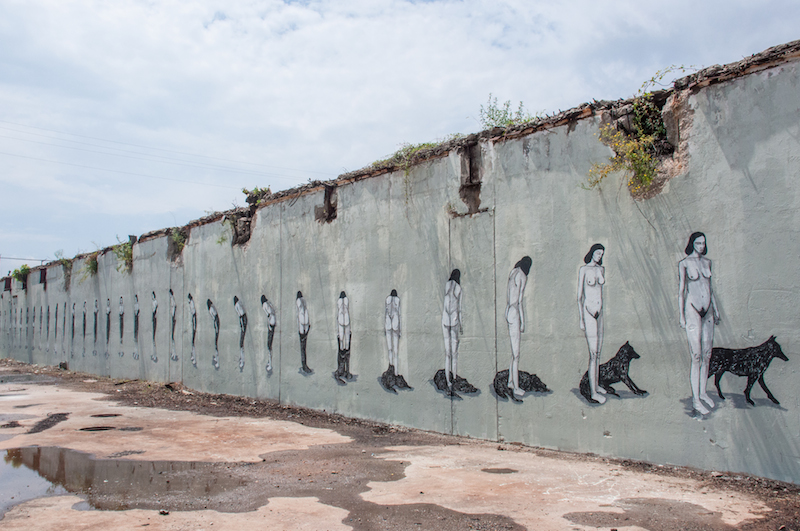Another common complaint is that a lot of street art that appears across the online street art community is clearly put up just for the sake of getting a cool photo. The work is so temporary that hardly anyone would see it without seeing it in a photo. That definitely happens. Hell, I’ve written about that practice over and over in this chapter as a potentially innovative and interesting way of making art. People do street art for the purpose of taking a photo of it and posting that photo online where a blog might pick it up or where their worldwide social media fanbase can see it.
The install, document and dismantle category of street art is a subcategory of for-the-photo street art, and while that sort of work can be really interesting, segments of that community catch a lot of shit from the rest of the street art world about how they utilize the street and the street cred that comes from being associated with street art. It seem that this animosity has to do with the idea that these artists aren’t really street artists, but are instead just trying to get fame and money riding the coattails of real street artists who risk their freedom and to put up art for the public. I’m sure there’s an element of that with some artists doing install, document and dismantle work. After all, that’s the sort of thing people do when a subculture become cool and potentially financially lucrative. At the same time though, I think a lot of the artists doing install, document and dismantle work are actually doing amazing work, it’s just not necessarily intended to be seen on the street.

This yarn bomb by Ishknits probably didn’t last too long. Another piece she installed on the same sculpture only lasted a few minutes. Photo by Ahd Photography.
In a discussion over Twitter in October 2012 between Conrad Benner (@StreetsDept), Caroline Caldwell (@DIRT_WORSHIP), Chris M Clark (@chrismclark), and Jason Eppink (@jasoneppink), Benner asked how someone could write off the entire medium of yarn bombing. Caldwell and Clark both pointed to yarn bombing’s limited legal risk compared to other forms of street art even though practitioners of yarn bombing often try to associate themselves with street art, and Caldwell and Eppink both noted the super-temporary nature of the medium with Eppink going so far as to tweet, “Yarn bombing exemplifies the ‘do it for the photo’ method of street art. There’s a disingenuousness.” I think that, for many people, these same reasons for negativity about yarn bombing probably extend to other forms of install, document and dismantle street art and for-the-photo street art in general.
The unverified stories about work appearing on blogs as street art even though the pieces were clearly done in the artist’s backyard describe the epitome of for-the-photo street art that people love to hate. It seems that those artists, if indeed they actually existed, cared less about people seeing their work on the street. They wanted people to get their art on a major blog. One loophole for work put up in abandoned spaces must be noted here: Yes, that work could be considered by some to be for-the-photo street art, but it’s more respected because it still involves an element of risk that some people see as essential to street art and graffiti, even if the work won’t be seen by everyday passersby. Plus, abandoned spots are cool.

A portion of Hyuro’s mural in Atlanta, the entirety of which has since been removed. Photo nickmickolas.
The most serious problem I see with for-the-photo street art is that the artists sometimes forget about the community in which they are painting, which is problematic when for-the-photo work is not also intended as install, document and dismantle work. There seems to be a trend, particularly among street art festivals, of this bigger-is-better mentality where every artist wants to paint the biggest mural ever. That is coupled with a trend of artists just flying into town, painting a mural based on a random sketch pulled from their sketchbook that has nothing to do with the particular spot they are painting or the local community and then leaving forever. The result of these two trends combined are massive these cookie-cutter murals with no site-specificity popping up in cities everywhere at mural festival after mural festival. It’s like the 21st century version of those stupid plop art abstract sculptures that you see in city centers, except that instead of being the result of art-by-committee, these cookie-cutter murals are the result of art-by-internet-appeal. After all, these works do like great in a photo.
These trends are, arguably, what led to the problem that the Living Walls program in Atlanta faced in 2012 when two of their murals (one by Hyuro and one by Roti) were painted over after neighborhood residents objected to them and both murals were subsequently vandalized. While I supported keeping both murals, it may have been wrong of me to do so. An essential question that the street art community is grappling with right now is what obligations, if any, artists and mural organizers have in making sure that artists engage with the communities in which they are painting and abide by any requests that community members make, particularly when thinking about legal walls. On the one hand there’s artistic freedom and on the other the needs of the community. I’m not sure what the answer is, but I think it’s clear that it is possible to go too far towards doing work for an online audience which neglects the people who have to walk by the piece every day (for example, writing “FUCK SCHOOL” 20-feet tall on an elementary school is probably unwise no matter how cool it may look in a photograph). For now, there’s not much more I can say. We don’t yet know exactly where that line between artistic freedom and responsiveness to the community is. Finding the exact balance is likely the next big question that street artists and their supporters will have to tackle.
For now, I guess the question is, “Is for-the-photo street art a good thing?” A lot of people would say that it’s not. I say that it depends. Sometimes for-the-photo street art is amazing. Other times, it’s completely terrible and poorly executed. Sending a drone into the air to photograph a message you’ve written on the ground or setting up a sculpture that will excite a few passersby but then taking it home with you can be great. Wheatpasting something over a piece of graffiti on a wall of fame just for a video is a dick move.